Diese E-Mail-Adresse ist vor Spambots geschützt! Zur Anzeige muss JavaScript eingeschaltet sein!
Fukushima aktuell
![]()
![]()
![]()
Recent presentations of the Admin on the severe accidents in TMI, Chernobyl and Fukushima.
Recent presentations of the Admin on German Nuclear Rules and Regulations.
The TEPCO accident report reveals the failure of the emergency measure "mobile injection by fire trucks". The admin has provided an English translation of the chapter on the role of the fire trucks from the TEPCO accident report. Click here.
New: Google presents street view type of pictures of tsunami damaged buidling. Very instructive for people interested in tsunami damage:
http://www.miraikioku.com/streetview/en/building
Strange understanding of the Defence-in-Depth principle in the new German "BMU Safety Criteria for Nuclear Power Plants - Revision D (2009)". Some comments by the admin, click here to read.
October 3rd, 2013 - Shit happens - A very instructive example of a nuclear incident
In order to store the increasing amounts of decontaminated water from the water treatment facility TEPCO keeps building large tanks on a site that has been cleared and sealed before the constuction. The site has a slight inclination towards the sea to guaranty that even in heavy rain fall the rain water will flow away safely. Since each downhill row of tanks is interconnected, the bottom tank will overflow first while the top tank uphill is not filled up to the safety margin. Shit happens, the water level indicatorfor the row of tanks was installed in the first tank uphill. The protection against tank leackage is a dyke around the tanks. That is fine, because even in case of overflow the water will be kept inside the dyke and not flow direction sea.
The poor worker pumped water from the pool inside the dyke into the tank watching at the same time the water level indicator which showed sufficient tank capacity available and the water level inside the dyke which was rapidly falling.
The tanks were equipped with a steel galery some feet below the top to allow visual inspection of the tank from above. And this is where the shit happened. The tank with the water level indicator still had sufficient capacity but the last tank downhill was overflowing ... but the water did not flow down into the area with the dyke but due to the gallery it was spilled over the dyke and was flowing away direction sea.
The pictures illustrate the situation:
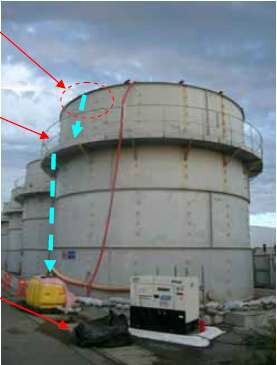
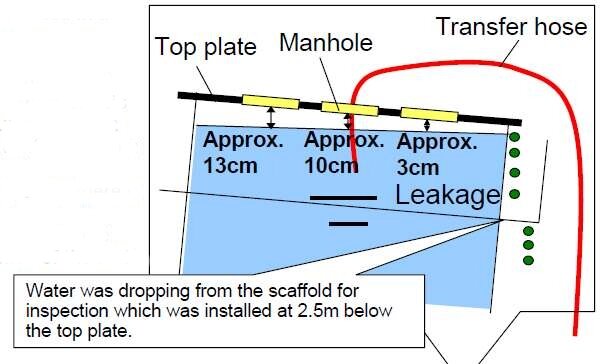
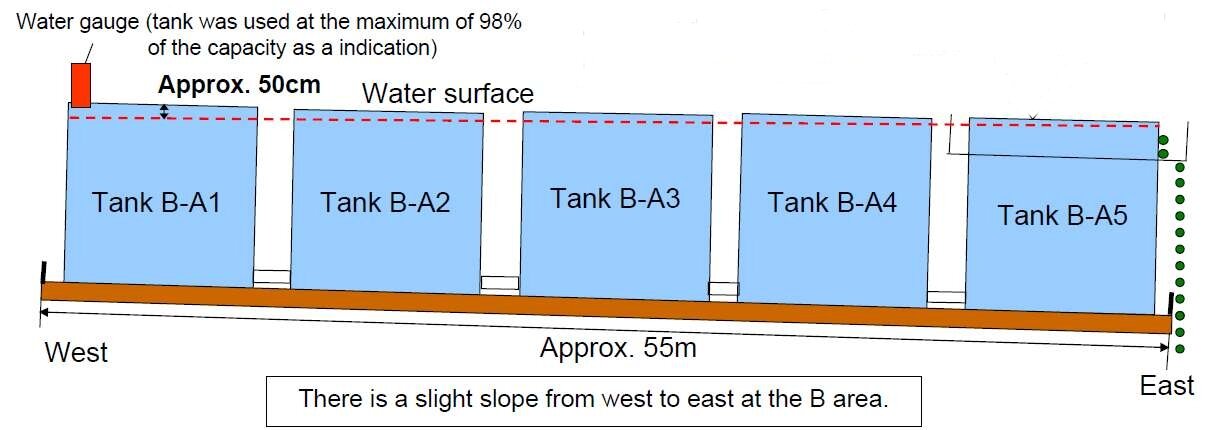
The press release from TEPCO created a full size press panic: All papers went mad and readers asked why the Japanese government has not ask for the assistance of international experts.
This leads to the question, how international experts might have helped to avoid this incident, which is typical for nuclear incidents, caused by the combination of minor flaws in the design and the guidelines for workers.
Some days later, TEPCO published the radiological analysis of the spilled water: about 50 Bq/l Cesium and some Betas. Much ado about nothing.
After a heavy rain fall a worker was ordered to pump rain water assumed to be contaminated from inside the dyke into the tanks, which had enough capacity left.
September 2013 - the great ground water panic continued - German press in full panic and out of mind
German press spreds the terrifying news that TEPCO has dumped lots of contaminated groundwater water into the sea with the unimagenable high level of 30 Bq/liter (!?!). Clearly the end is at hand! Or at least, this is how the press sees it.
According to the press, at the same time pour TEPCO has lost control of the situation, TEPCO is completely confused which can be seen from the fact that in one of the many reports TEPCO has written the name of the prime minister wrong. Unbelievable mistake writing one of the funny characters of his name on his badge during the Fukushima visit wrong!
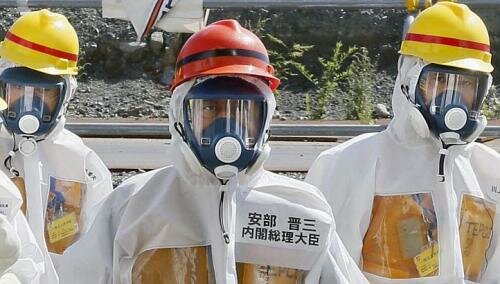
The admin prefers not to comment on this nonsense. The admin wants to point out that the Fukushima catastrophy is a serious accident and deserves the press to report seriouly on the developments on-site.
The real accident and the impact on the environment is over and there is no risk of a future massive radioactive release.
Therefore the admin will discontinue reporting on the clean-up process.
The figure shows the situation on the accident site as of September 9th,2013
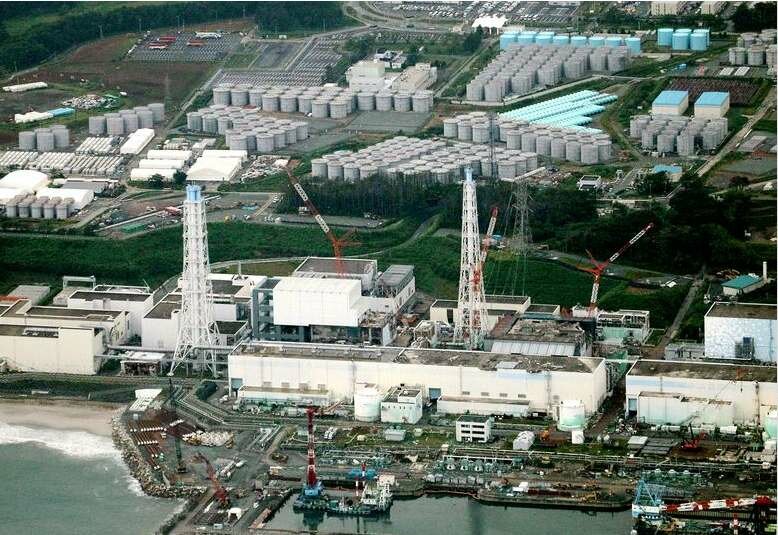
The photo shows the main tasks underway (from top to bottom)
- Tanks and reservoirs for filtered water and radwaste from the filters
- control pits for ground water control in the green area
- clean-up and construction of housings for the damaged rector buildings (unit 1 housing is not in the picture)
- ground improvement on border of the port to control ground water flow.
TEPCO has promised
- to decommission unit 5 and unit 6, which are not damaged, in order to concentrate its qualified manpower on the clean-up of unit 1 to 4.
- to solve the problem of the increasing amount of contminated water by stopping the ground water leackage into the reactor building basements
- to provide addtional fundings for additional work, if needed.
August 2013 - the great ground water panic continued
The Japanese government tells it so well and the press is publishing it without any critical reflection: 1000 m3/d of ground water are flowing towards the Fukushima Daichi plants, 400 m3/d penetrate into the basements of the plants and are pumped into the decontamination facility. According to the goverment and the press only 300 m3/d of ground water flow into the sea. This is a real mystery: 300 m3/d of ground water disappear on the site! According to the fundmental laws of physics mass is not created or disappears under normal conditions: So what? A real secret. Figure from Asahi Shibum.
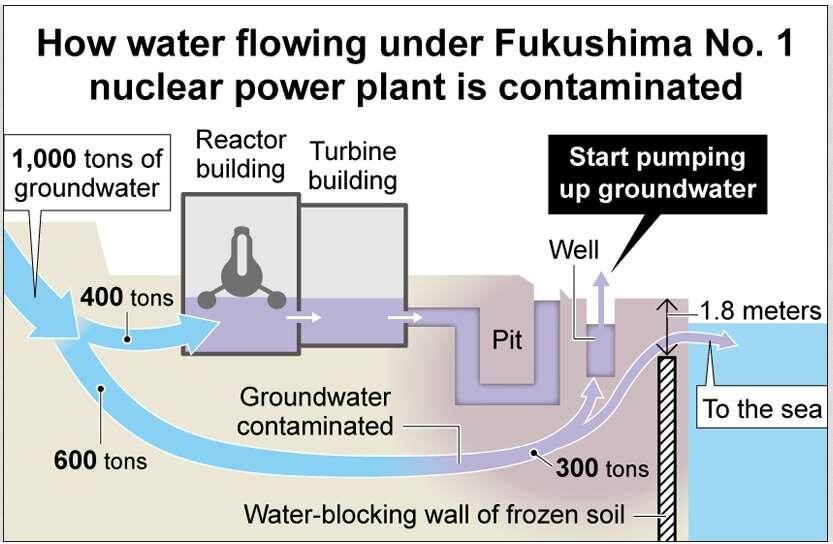
In order to block the ground water flow into the sea, the government favours a technique in which the soil is frozen by cooling injection along the blue line in the figure. This is not difficult but requires permanent cooling action in contrast to chemical soil improvement. The data on the ground water contamination published by TEPCO do not justify this installation. Work force and money can be used better in a more rapid clean-up.
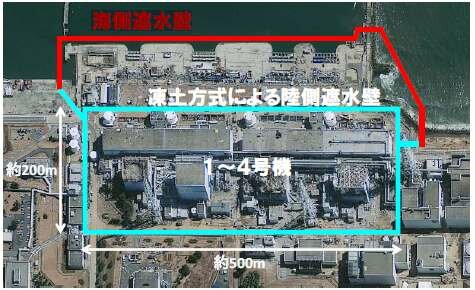
August 2013 - TEPCO report on lessons learned
Improvement of backup systems
TEPCO has published a new Nuclear Safety Reform Plan Progress Report (130726e0402.pdf) which presents some interesting ideas which apply to German NPPs as well. One of these ideas is the improvement of the defence-in-depth features of the reactor cooling system, which have been strengthened and now provide six levels of backup systems, as shown in the figure.

It can be seen that three different types of pumps and three different tanks which are part of the plants installations can be used for coolant water injection in case of emergency. In addition refill of the water tanks and mobile pump injection can be carried out by fire trucks. If everything goes wrong, the final backup is the mobile injection of sea water by fire tucks.
In this report a figure called "Fighting the negative spiral" can be found which is quite astonishing in view of the common understanding that the Japanese are not open minded and willing to accept that something in their approach might be wrong. Actually also German nuclear safety responsibles could learn a lot from this diagram. The diagram identifies closed circles in the safety approach and in the thinking of the responsables and these issues are exactly the same as in Germany.
Safety Awareness: Responsables will always say that safety has been established and cannot be improved, especially the Germans think their NPPs are the safest in the world.
Technical Capabiliy (of system and components): The plant personal does not sufficiently understand all aspects, especially those important in a severe accident.
Technical Capability (of work force): Insufficient capabilities and training of the work force on-site.
Communication: Poor communication skills, no common understanding.
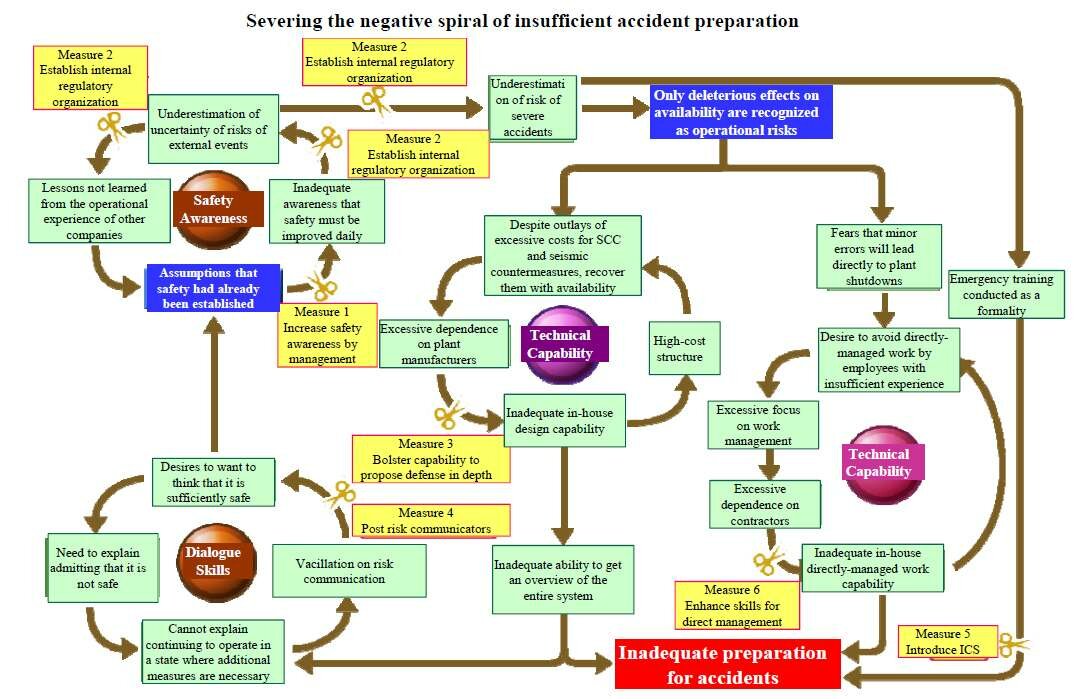
ICS = Incident Command System
It should also be stated that many proposals in the report are questionable, e.g. building a huge concrete tsunami wall may help if the tsuanmi height is below this wall height, but - the tsunami might be higher, and in this case a closed wall will keep the plant flooded, it simply lacks mobile openings to allow the water to flow back into the sea.
August 2013 - The great ground water panic
The Japanese government and press finally have realized that groundwater from around the destroyed plants is flowing into the sea. In most nuclear plants the ground water level is well below the plant's basemat but in Fukushima the situation is different. The plants foundations reach into a low permeable layer such that the plant's basement are in direct contact with the ground water. The ground water is flowing down from the hills behind the plants into the sea, as shown in the figure.
ground water level

In order to avoid radioactive leackage from the basements filled with highly contaminated water, TEPCO is keeping the water level inside the basements below the ground water level. This causes a ground water flow of 400 m3/d into the basements, which is pumped into the decontamiantion facilities and afterwards stored in tanks or reused as cooling water to be injected into the reactors. The difference in water level should results in a flow direction from outside to inside, but there may be some strange effects which could result into the reversal of the flow direction. In order to avoid such effects TEPCO has tried to fix all leackages in tunnels and cable channels. It is reasonable to assume that actually there is no substantial leackage from the basements to the ground water.
So, where does the ground water contamination come from?
Basically there a two sources:
1) Immediately after the accident a substantial amount of radioactive material was depositied around the plants, which was partially immobilized by sprays while the rest escaped into the ground. From experiments we know that the radioactive particals move slowly downward from the surface into the ground, mainly transported by rain water. Sooner or later the radioactive material will reach the ground water.
2) In the course of the accident there was a substantial leackage of highly contaminated water into a tunnel leading to the port water intake, which resulted into a massive contamination of the soil around the leackage. TEPCO build a silt fence to keep the contaminated ground water from flowing into the port. The leackage took place close to the pit, where the high contamination level was observed lately. (See below pit No. 1-2)
ground water flow pattern
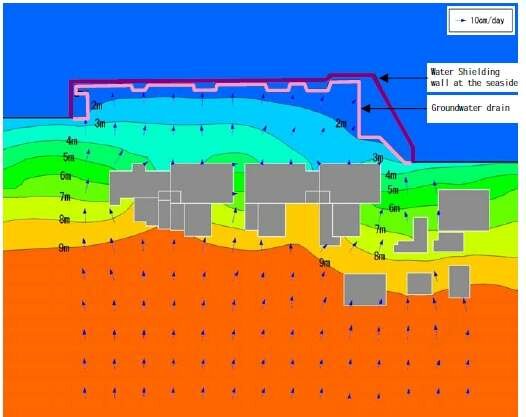
Since June 2013 TEPCO started to build a more solid construction to solve the problem. The idea is to lower the ground water level on the hillside of the plants by pumping the water from a set of wells and at the same time improve the ground at the port side where the silt fence was build making it impermeable by injecting chemicals. These works led to the finding that the ground water close to the port is contaminated and some of it is also leacking into the port, but the contamination levels in the port are low - no reason to panic. TEPCO took additional measure like putting nets in the port to keep potenially contaminated fish inside the port.
When the Japanese goverment and the press became aware of this issue, they saw their chance to catch public interest and publicity. Compared to what has happened in the accident in 2011 this is neglectible and it is no surprise but exactly what an expert whould have expected.
July 2013 - Progress and Incidents
1) Whitish cloud causes full alert
During clean-up work on the unit 3 upper level a contract worker observed a mysterious small whitish cloud at the border of the shiel plug and took a picture showing a small hardly discernible whitish cloud.
We remember: TEPCO is cleaning the complete destroyed fifth floor of unit 3 from debris in order to have access to the spent fuel pool, where some spent fuel elements are stored , which have to be removed a soon as possible. In the middle of the fifth floor there is the shield plug on top of the containment. Its task is to block the deadly radiation from the containment.
A white cloud could be smoke or steam but there should not be either smoke or steam. So TEPCO ran the full program and found:
No high temperatures inside the containment.
No hot spot on the fifth floor: No increased radiation levels: the radiation readings around the shield plug ranged from 137 to 1860 mySv/h and 562 ySy/h at the location where the cloud has been observed.
Temperature measurements by an infrared camera also showed nothing but a irrelevant elevated temperatures at the spot where the cloud had been observed.
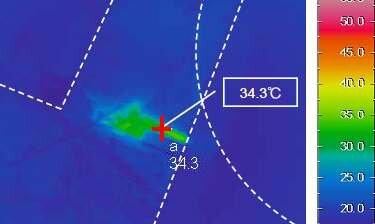
Basically: There is something, but it does not indicate an imminent danger.
2) Unit 4 cover progress
On July 20th TEPCO achieved a milestone in the removal of the highly radioactive fuel elements from the spent fuel pool (SPF) of unit 4. We remember: After the removal of the debris from the fifth floor TEPCO started the construction of a partial housing which would allow to remove the fuel elements from the SPF under controlled atmopshere. In difference to unit 1 to 3, where only some spent fuel elements were stored in the SPF, in the unit 4 SPF the complete core was stored when the accident occurred. A spent fuel element is highly radioactive. Therefore it has always to be kept under water for shielding. Exposure of a human being to one single spent fuel element in the open without shielding will result in immediate death. The removal of hte spent fuel elements from unit 4 SPF is of highest priority.
TEPCO has now completed the housing shell consisting of the steel frane and the outer wall and roof panels.
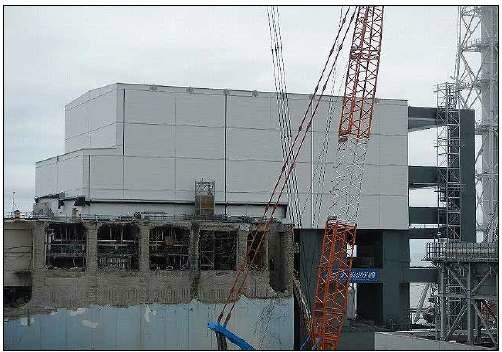
3) Ground Improvement and the Tritium Problem
As the amount of decontaminated water in the tanks keeps rising, TEPCO started a ground improvement program in order to keep the groundwater from flowing into the port in May 2013. First TEPCO started a very detailed monitoring programm of the groundwater and drilled new bore holes for monitoring. One bore hole (No.1-2) turned out to be a hot spot for tritium. Other location showed higher values of tritium than before. So TEPCO became extra-nervous and started the full programm: Additional bore holes, groud improvement at the port side and additional nets and blockages to prevent fish (potentially contaminated) fromescaping out of the port into the open waters
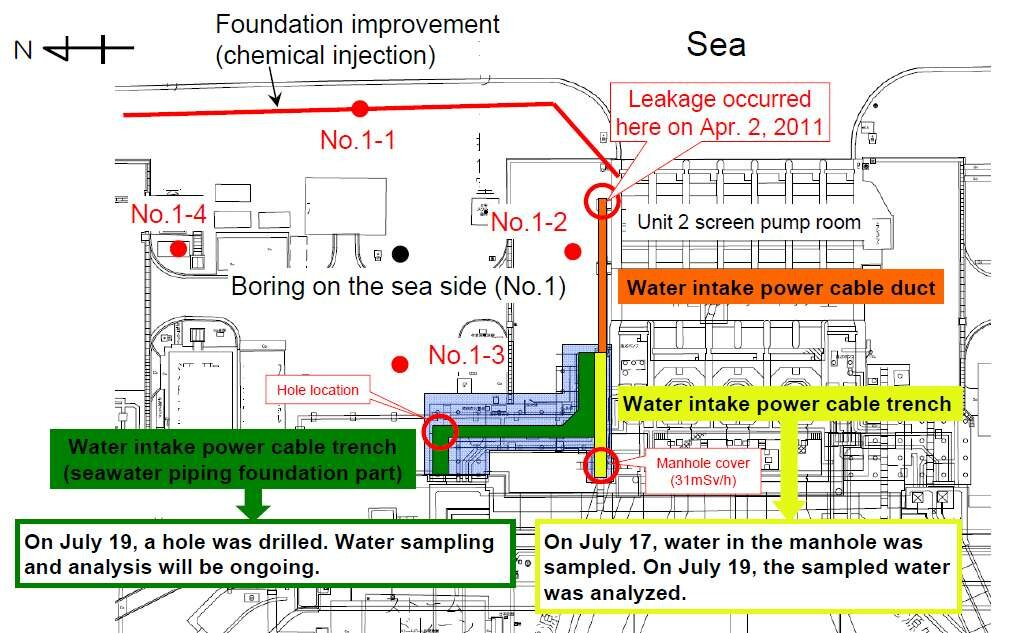
But nothing found was really alarming: The high tritium valus of bore hole No.1-2 are easily explained by the fact that this hole is close to the cable duct where a substantial radioactive leackage occurred during the accident. The tritium vaules in the seawater are well below the legal notification level of 60.000 Bq/l. Of course, the groundwater around the units is highly contaminated but the silt fence installed after the accident and the fixing of the leackages have kept the radioactivety from escaping into the port.
The press panicked when TEPCO published that a fish was caught inside the port which had 1000 Bq/kg Cesium - 2 times the EC limit but 10 times the Japanese limit.
June 2013 Progress and Incidents
1) Water leak from the underground reservoir
After pumping the water from the suspected underground reservoir, no increase in radioactive levels in the control pits was found: problem resolved.
2) Tritium inside the port
The detection of higher than expected levels of Tritium inside the port water lead to a detailed investigation wihich resulted in finding tritium in many control pits. The highest level detected was 420.000 Bq/L in the underground observation hole No 1-1 ( = hole number one at unit one).
Tritum is the H3, which means it is chemically not different from hydrogen and it is easily incorporated in all living material in form of water. In every NPP vast amounts of Tritium are produced which have to be released to the environment. In the Fukushima vast amounts of Tritium have been released and so it is not a surprise that it can be found everywhere around the units. The level of Tritium inside the port water and the underground water indicates that Tritium might be leaking from the basements of the units which are full with contamintated water.
The radiollogical impact of Tritum is very low. Tritium is a weak beta emitter with a half-life of 12.3 years. The final biological impact of tritium is low. The other point about Tritium is that it is hard to measure and hard to detect.
Basically the problem is not the level of Tritium but the potential leak from the basements. The outcry in the press is not justified at all.
3) Water leakage from the desalination system
A small leakage from the desalination system has been detected, reported and fixed.
4) Oil leakage at the construction site
Some mechinary lost some oil: Peanuts in a highly ontaminated environment.
5) Failure of a charger panel
A mouse found its way into the charger panel of a mobile power generator. It stopped and the back-up generator started. Problem was fixed by placing rodent control into the openings of the charger panel.
6) Fire near comon incineration facility
Some junk material waiting for incineration started to burn. Nobody knows why and how, but the workers took a fire exstinguisher and extinguished the fire. Peanuts.
7) Construction of a new radwaste treatment facility
TEPCO is constructing a new large concrete building for radwaste treatment. First pooring of concrete took place. The picture published by TEPCO shows a large solid basemat.
8) New safety report for Fukushima Daichi
TEPCO has published an updated safety report for the damaged plant (in Japanese) with many details of the clean-up process: 3155 pages of detailed information.
June, 10, 2013, Comments by the Admin on the Fukushima Clean-up Progress and the floods in Germany
Fukushima Clean-up Progress in Mai 2013
It is rather boring to read the information on the Fukushima progress since there is almost no progress. TEPCO has finished the steel frame for the unit 4 housing, it has build an improved cover over the unit 3 spend fuel pool and it is investigating the leaking of one (or more ?) underground tanks. It has published more than 200 follow-up reports on this (less important) leakage and also has published fotos and movies of low information value. Basically, there are no milestones that have been achieved and no serious incidents or accidents.
The amount of water stored in tanks is increasing as before and sooner or later TEPCO will apply for a license to dump the treated water into the sea. From a technical point of view this could be done without violating the radiation protection limits but it will not be accepted by the public. So the stragey of TEPCO is to continue with the storage in tanks until the public will accept the dumping.
TEPCO is dicussing various methods to keep the ground water from flowing into the basements, BUT in order to prevent the radioactive water in the basement which is leaking down from the containment, the groundwater level must be kept above the water level in the basement. There is no simple solution for this problem, all TEPCO may hope for is that it might decrease the inflow of groundwater but closing the major leaks in the basement walls at the price of a substatnial radiation load on the workers performing this job.
Flood in Germany
Germany is experiencing one of the biggest floods ever recorded. The public and the press are blaming the government for not having build dykes high enough for this flood. This is a very interesting phenomenon. The German public is heavily relying on desaster prevention and believing that engineered safety systems can be implemented that will cope with any situation possible.
This is similar to the situation in nuclear safety where the responsible persons fool the public by explaining that all risks can be avoided by enginered safety systems. This is not true for floods and not true for nuclear accidents. Up to a certain limit safety systems can limit the consequence of a flood or a malfunctining in a nuclear power plant. But there is this limit and this has to be accepted by the responsible persons and the public. If you build a dyke for floods of 8 m height, the next flood will have a height of 8,20 m and everything will be lost. Clearly any emergency preparedness has two component prevention and mitigation: For floods Germany needs more than dykes and people who put sand sacks on dykes to increase the height. Mitigation is also needed and this requires a certain flood preparedness: Buildings and installations which can be easily evacuated and cleaned after the flood, roads of approach along the dykes, and machinery to add big sand sacks to the dykes and not these folk festivals on the dykes with people putting 10 kg sacks to the dykes and politicians visiting these people shaking hands and hoping these scenes will make it to the evening news on tv.
The same is true for nuclear power plants: In addition to all the well designed safety systems, all equipment needed for mobile injection and movile power supply has to be available on-site and workers must be trained to execute the emergenca procedures. It is a severe mistake to think that because of the very low level of probability these mitigation measures are not necessary and therefore are not taken serious by the responsible persons.
May 2013 - Fukushima Clean-Up and Incidents - Click here
April 2013 - Fukushima Clean-Up and Iincidents - Click here
March 2013 - Fukushima Clean-Up and Incidents - Click here
February 2013 - Fukushima Clean-Up and Incidents - Click here
January 2013 Incidents - click here
December 2012 Incidents - click here
November 2012 Incidents - click here
October 2012 Incidents - click here
September 2012 Incidents - click here
August 2012 Incidents - click here
July 2012 Incidents - click here
June 2012 Incidents - click here
Weitere Meldungen aus dem Monat Mai 2012
Weitere Meldungen aus dem Monat April 2012
Weitere Meldungen aus dem Monat März 2012
Das Password ist "fukushima-11-3-2011".
This site is provided by an independent nuclear senior expert. If you have questions or comments, please feel free to contact him:
Diese E-Mail-Adresse ist vor Spambots geschützt! Zur Anzeige muss JavaScript eingeschaltet sein!
Aktuell sind ein Gast und keine Mitglieder online
Digitize your plot on paper with your mouse!
![]()
Japanischer Fernsehsender NHK auf ASTRA, Kanal 787

http://www.amazon.de/Nuclear-Safety-Light-Water-Reactors/dp/0123884462/ref=sr_1_sc_1?ie=UTF8&;qid=1336588255&sr=8-1-spell
Petition
Abschaffung der GEZ
Keine Zwangsfinazierung
https://www.openpetition.de/petition/online/abschaffung-der-gez-keine-zwangsfinanzierung-von-medienkonzernen